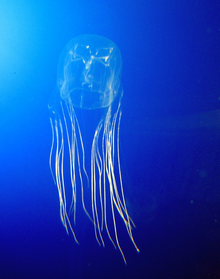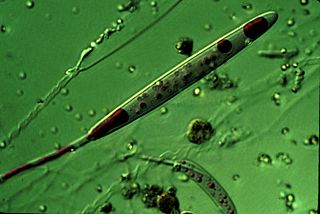
A cnidocyte is an explosive cell containing one giant secretory organelle called a cnidocyst that can deliver a sting to other organisms. The presence of this cell defines the phylum Cnidaria. Cnidae are used to capture prey and as a defense against predators. A cnidocyte fires a structure that contains a toxin within the cnidocyst; this is responsible for the stings delivered by a cnidarian.

Box jellyfish are cnidarian invertebrates distinguished by their box-like body. Some species of box jellyfish produce potent venom delivered by contact with their tentacles. Stings from some species, including Chironex fleckeri, Carukia barnesi, Malo kingi, and a few others, are extremely painful and often fatal to humans.

Chironex fleckeri, commonly known as the Australian box jelly, and nicknamed the sea wasp, is a species of extremely venomous box jellyfish found in coastal waters from northern Australia and New Guinea to Malaysia, the Philippines and Vietnam. It has been described as "the most lethal jellyfish in the world", with at least 64 known deaths in Australia from 1884 to 2021.
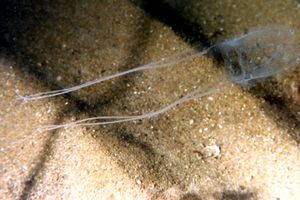
Carybdea is a genus of venomous box jellyfish within the family Carybdeidae that currently consists of a total of 8 species. This genus of jellyfish are often found in warm waters around the world in waters such as the Mediterranean Sea, the Pacific Ocean, and off the coast of Africa. Their sting can cause a range of effects depending on the species. These invertebrates will go through both sexual and asexual reproduction as they transform from a polyp to medusa. Carybdea have a box-shaped bell with four tentacles and eye-like sensory structures. There are distinct physical markings that differentiate many species within the genus. While Carybdea use their venom to act as predators, they are also preyed on by turtles and various fish. They feed on plankton, invertebrates, fish, and some crustaceans.

Chirodropidae is a family of venomous box jellyfish within the class Cubozoa.

Alatina alata(Reynaud, 1830), often called a sea wasp, is a species of box jellyfish found in the Pacific, Indian and Atlantic Oceans and in the Caribbean and Arabian Sea.

Carukia is a genus of box jellyfish in the Carukiidae family.
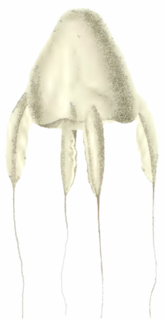
Alatinidae is a family of box jellyfish within class Cubozoa, containing the following genera and species:
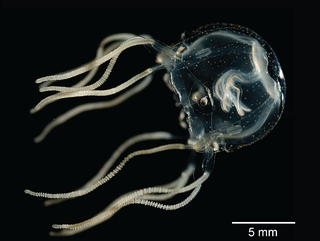
Carybdeida is an order of box jellyfish. There are five families within the order. They are distinguished from other box jellyfish by the presence of unbranched muscular bases at the corners of the cubic umbrella. Most species have four tentacles.

Carukiidae is a family of box jellyfish within the Cubozoa class. Carukiidae can be easily classified by their lack of cirri clumps inside the cubozoan stomach, as well as the size and the placement of their nematocysts.

Tamoya is a genus of box jellyfish within the monotypic family Tamoyidae.

Tripedaliidae is a family of box jellyfish within class Cubozoa.
Ronald Vernon Southcott was an Australian medical zoologist specializing in Acari, mites and ticks.

Copula is a monotypic genus of box jellyfish in the family Tripedaliidae of the phylum Cnidaria. The only species in the genus is Copula sivickisi, a very small gelatinous, bell-shaped organism with four tentacles that is active only at night. It is unusual among box jellyfish in having a mating ritual and internal fertilisation. The specific name honours the Lithuanian zoologist Pranciškus Baltrus Šivickis.

Chironex yamaguchii, commonly known as habu-kurage in Japanese and as "hub jellyfish" due to erroneous machine translations, is a species of box jellyfish found in coastal waters around Japan, on Okinawa and the Ryukyu Islands, and in the Philippines. It is highly venomous.
Manokia is a genus of box jellyfish in the Alatinidae family.

Hugo Flecker was an Australian medical practitioner, radiotherapist, toxicologist and natural historian. He founded the North Queensland Naturalist Club in 1932, whose herbarium grew into the now heritage-listed Flecker Botanical Gardens in Cairns, Queensland. He identified the deadly box jellyfish, Chironex fleckeri.

Chiropsoides is a genus of box jellyfish in the family Chiropsalmidae. It is monotypic, with a single species, Chiropsoides buitendijki. The most distinct species characteristics are the shape of the gastric saccules, the pedalial canals, and the unilateral pedalial branching.

Chironex indrasaksajiae, locally known as Mangkaprun Klong, Mangkaprun Sarhai or Sarong, is a species of box jellyfish in a coastal water of the northern and eastern Gulf of Thailand. It has been accused of causing fatalities in the area as it is a member of the genus Chironex
Chiropsella bronzie is a species of box jellyfish. It is considered much less of a threat to humans than some of its relatives. The species was described in 2006, and is one of four species in the genus Chiropsella. Chiropsella bronzie can be found in shallow waters off the coast of Queensland, Australia.
